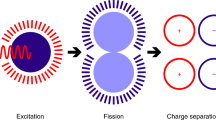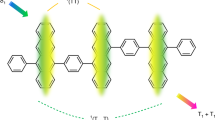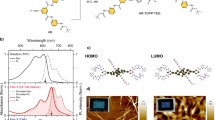Abstract
When an assembly of two or more molecules absorbs a photon to form a singlet exciton, and the energetics and intermolecular interactions are favourable, the singlet exciton can rapidly and spontaneously produce two triplet excitons by singlet fission. To understand this process is important because it may prove to be technologically significant for enhancing solar-cell performance. Theory strongly suggests that charge-transfer states are involved in singlet fission, but their role has remained an intriguing puzzle and, up until now, no molecular system has provided clear evidence for such a state. Here we describe a terrylenediimide dimer that forms a charge-transfer state in a few picoseconds in polar solvents, and undergoes equally rapid, high-yield singlet fission in nonpolar solvents. These results show that adjusting the charge-transfer-state energy relative to those of the exciton states can serve to either inhibit or promote singlet fission.
This is a preview of subscription content, access via your institution
Access options
Subscribe to this journal
Receive 12 print issues and online access
$259.00 per year
only $21.58 per issue
Buy this article
- Purchase on Springer Link
- Instant access to full article PDF
Prices may be subject to local taxes which are calculated during checkout





Similar content being viewed by others
References
Singh, S., Jones, W. J., Siebrand, W., Stoicheff, B. P. & Schneider, W. G. Laser generation of excitons and fluorescence in anthracene crystals. J. Chem. Phys. 42, 330–342 (1965).
Swenberg, C. & Stacy, W. Bimolecular radiationless transitions in crystalline tetracene. Chem. Phys. Lett. 2, 327–328 (1968).
Shockley, W. & Queisser, H. J. Detailed balance limit of efficiency of p–n junction solar cells. J. Appl. Phys. 32, 510–519 (1961).
Hanna, M. C. & Nozik, A. J. Solar conversion efficiency of photovoltaic and photoelectrolysis cells with carrier multiplication absorbers. J. Appl. Phys. 100, 074510 (2006).
Smith, M. B. & Michl, J. Singlet fission. Chem. Rev. 110, 6891–6936 (2010).
Chan, W.-L. et al. Observing the multiexciton state in singlet fission and ensuing ultrafast multielectron transfer. Science 334, 1541–1545 (2011).
Ramanan, C., Smeigh, A. L., Anthony, J. E., Marks, T. J. & Wasielewski, M. R. Competition between singlet fission and charge separation in solution-processed blend films of 6,13-bis(triisopropylsilylethynyl)pentacene with sterically-encumbered perylene-3,4:9,10-bis(dicarboximide)s. J. Am. Chem. Soc. 134, 386–397 (2011).
Chan, W.-L., Ligges, M. & Zhu, X. Y. The energy barrier in singlet fission can be overcome through coherent coupling and entropic gain. Nature Chem. 4, 840–845 (2012).
Roberts, S. T. et al. Efficient singlet fission discovered in a disordered acene film. J. Am. Chem. Soc. 134, 6388–6400 (2012).
Walker, B. J., Musser, A. J., Beljonne, D. & Friend, R. H. Singlet exciton fission in solution. Nature Chem. 5, 1019–1024 (2013).
Ma, L. et al. Singlet fission in rubrene single crystal: direct observation by femtosecond pump–probe spectroscopy. Phys. Chem. Chem. Phys. 14, 8307–8312 (2012).
Burdett, J. J. & Bardeen, C. J. Quantum beats in crystalline tetracene delayed fluorescence due to triplet pair coherences produced by direct singlet fission. J. Am. Chem. Soc. 134, 8597–8607 (2012).
Pensack, R. D. et al. Exciton delocalization drives rapid singlet fission in nanoparticles of acene derivatives. J. Am. Chem. Soc. 137, 6790–6803 (2015).
Margulies, E. A. et al. Sub-picosecond singlet exciton fission in cyano-substituted diaryltetracenes. Angew. Chem. Int. Ed. 54, 8679–8683 (2015).
Wang, C. & Tauber, M. J. High-yield singlet fission in a zeaxanthin aggregate observed by picosecond resonance Raman spectroscopy. J. Am. Chem. Soc. 132, 13988–13991 (2010).
Dillon, R. J., Piland, G. B. & Bardeen, C. J. Different rates of singlet fission in monoclinic versus orthorhombic crystal forms of diphenylhexatriene. J. Am. Chem. Soc. 135, 17278–17281 (2013).
Musser, A. J. et al. The nature of singlet exciton fission in carotenoid aggregates. J. Am. Chem. Soc. 137, 5130–5139 (2015).
Johnson, J. C., Nozik, A. J. & Michl, J. High triplet yield from singlet fission in a thin film of 1,3-diphenylisobenzofuran. J. Am. Chem. Soc. 132, 16302–16303 (2010).
Johnson, J. C. et al. Toward designed singlet fission: solution photophysics of two indirectly coupled covalent dimers of 1,3-diphenylisobenzofuran. J. Phys. Chem. B 117, 4680–4695 (2013).
Eaton, S. W. et al. Singlet exciton fission in polycrystalline thin films of a slip-stacked perylenediimide. J. Am. Chem. Soc. 135, 14701–14712 (2013).
Eaton, S. W. et al. Singlet exciton fission in thin films of tert-butyl-substituted terrylenes. J. Phys. Chem. A 119, 4151–4161 (2015).
Hartnett, P. E. et al. Effects of crystal morphology on singlet exciton fission in diketopyrrolopyrrole thin films. J. Phys. Chem. B 120, 1357–1366 (2016).
Müller, A. M., Avlasevich, Y. S., Schoeller, W. W., Müllen, K. & Bardeen, C. J. Exciton fission and fusion in bis(tetracene) molecules with different covalent linker structures. J. Am. Chem. Soc. 129, 14240–14250 (2007).
Margulies, E. A., Shoer, L. E., Eaton, S. W. & Wasielewski, M. R. Excimer formation in cofacial and slip-stacked perylene-3,4:9,10-bis(dicarboximide) dimers on a redox-inactive triptycene scaffold. Phys. Chem. Chem. Phys. 16, 23735–23742 (2014).
Liu, H. et al. Synthesis and photophysical properties of a ‘face-to-face’ stacked tetracene dimer. Phys. Chem. Chem. Phys. 17, 6523–6531 (2015).
Zirzlmeier, J. et al. Singlet fission in pentacene dimers. Proc. Natl Acad. Sci. USA 112, 5325–5330 (2015).
Sanders, S. N. et al. Quantitative intramolecular singlet fission in bipentacenes. J. Am. Chem. Soc. 137, 8965–8972 (2015).
Lukman, S. et al. Tuneable singlet exciton fission and triplet–triplet annihilation in an orthogonal pentacene dimer. Adv. Funct. Mater. 25, 5452–5461 (2015).
Korovina, N. V. et al. Singlet fission in a covalently linked cofacial alkynyltetracene dimer. J. Am. Chem. Soc. 138, 617–627 (2016).
Greyson, E. C., Vura-Weis, J., Michl, J. & Ratner, M. A. Maximizing singlet fission in organic dimers: theoretical investigation of triplet yield in the regime of localized excitation and fast coherent electron transfer. J. Phys. Chem. B 114, 14168–14177 (2010).
Scholes, G. D. Correlated pair states formed by singlet fission and exciton–exciton annihilation. J. Phys. Chem. A 119, 12699–12705 (2015).
Monahan, N. & Zhu, X. Y. Charge transfer-mediated singlet fission. Annu. Rev. Phys. Chem. 66, 601–618 (2015).
Bakulin, A. A. et al. Real-time observation of multiexcitonic states in ultrafast singlet fission using coherent 2D electronic spectroscopy. Nature Chem. 8, 16–23 (2016).
Holtrup, F. O. et al. Terrylenimides: new NIR fluorescent dyes. Chem. Eur. J. 3, 219–225 (1997).
Kasha, M., Rawls, H. R. & El-Bayoumi, M. A. The exciton model in molecular spectroscopy. Pure Appl. Chem. 11, 371–392 (1965).
Settels, V., Liu, W., Pflaum, J., Fink, R. F. & Engels, B. Comparison of the electronic structure of different perylene-based dye-aggregates. J. Comput. Chem. 33, 1544–1553 (2012).
Lee, S. K. et al. Electrochemistry, spectroscopy and electrogenerated chemiluminescence of perylene, terrylene, and quaterrylene diimides in aprotic solution. J. Am. Chem. Soc. 121, 3513–3520 (1999).
Giaimo, J. M., Gusev, A. V. & Wasielewski, M. R. Excited-state symmetry breaking in cofacial and linear dimers of a green perylenediimide chlorophyll analogue leading to ultrafast charge separation. J. Am. Chem. Soc. 124, 8530–8531 (2002).
Vauthey, E. Photoinduced symmetry-breaking charge separation. Chem. Phys. Chem. 13, 2001–2011 (2012).
Teichen, P. E. & Eaves, J. D. A microscopic model of singlet fission. J. Phys. Chem. B 116, 11473–11481 (2012).
Zimmerman, P. M., Bell, F., Casanova, D. & Head-Gordon, M. Mechanism for singlet fission in pentacene and tetracene: from single exciton to two triplets. J. Am. Chem. Soc. 133, 19944–19952 (2011).
Zeng, T., Hoffmann, R. & Ananth, N. The low-lying electronic states of pentacene and their roles in singlet fission. J. Am. Chem. Soc. 136, 5755–5764 (2014).
Berkelbach, T. C., Hybertsen, M. S. & Reichman, D. R. Microscopic theory of singlet exciton fission. II. Application to pentacene dimers and the role of superexchange. J. Chem. Phys. 138, 114103 (2013).
Chan, W.-L. et al. The quantum coherent mechanism for singlet fission: experiment and theory. Acc. Chem. Res. 46, 1321–1329 (2013).
Beljonne, D., Yamagata, H., Brédas, J. L., Spano, F. C. & Olivier, Y. Charge-transfer excitations steer the Davydov splitting and mediate singlet exciton fission in pentacene. Phys. Rev. Lett. 110, 226402 (2013).
Yost, S. R. et al. A transferable model for singlet-fission kinetics. Nature Chem. 6, 492–497 (2014).
Casanova, D. Electronic structure study of singlet fission in tetracene derivatives. J. Chem. Theory Comput. 10, 324–334 (2014).
Young, R. M. et al. Ultrafast conformational dynamics of electron transfer in ExBox4+ perylene. J. Phys. Chem. A 117, 12438–12448 (2013).
Greenfield, S. R. & Wasielewski, M. R. Near-transform-limited visible and near-IR femtosecond pulses from optical parametric amplification using type II β-barium borate. Opt. Lett. 20, 1394–1396 (1995).
Acknowledgements
This work was supported by the Chemical Sciences, Geosciences, and Biosciences Division, Office of Basic Energy Sciences, US Department of Energy (DOE) under Grant No. DE-FG02-99ER14999 (M.R.W.). The authors thank R. D. Schaller for performing phosphorescence measurements. G.C.S. was supported by the Argonne-Northwestern Solar Energy Research (ANSER) Center, an Energy Frontier Research Center funded by the Office of Science, Office of Basic Energy Sciences, US DOE, under award number DE-SC0001059.
Author information
Authors and Affiliations
Contributions
E.A.M. synthesized the molecules, analysed the data and prepared the manuscript, C.E.M. acquired the fsTA data and performed the computational studies, Y.W. performed the redox titration experiments, L.M. performed the TRF measurements, R.M.Y. analysed the fsTA data. G.C.S. directed the computational modelling. M.R.W. designed the experiments, directed the investigations and prepared the manuscript with contributions from all the authors; all the authors contributed to discussions.
Corresponding author
Ethics declarations
Competing interests
The authors declare no competing financial interests.
Supplementary information
Rights and permissions
About this article
Cite this article
Margulies, E., Miller, C., Wu, Y. et al. Enabling singlet fission by controlling intramolecular charge transfer in π-stacked covalent terrylenediimide dimers. Nature Chem 8, 1120–1125 (2016). https://doi.org/10.1038/nchem.2589
Received:
Accepted:
Published:
Issue Date:
DOI: https://doi.org/10.1038/nchem.2589
This article is cited by
-
Enhancing the deep-red/near-infrared fluorescence of higher rylene diimides via the chalcogen-annulation strategy
Science China Chemistry (2024)
-
Quantum interference effects elucidate triplet-pair formation dynamics in intramolecular singlet-fission molecules
Nature Chemistry (2023)
-
Orbital-resolved observation of singlet fission
Nature (2023)
-
Singlet fission dynamics modulated by molecular configuration in covalently linked pyrene dimers, Anti- and Syn-1,2-di(pyrenyl)benzene
Communications Chemistry (2023)
-
Accelerating symmetry-breaking charge separation in a perylenediimide trimer through a vibronically coherent dimer intermediate
Nature Chemistry (2022)



